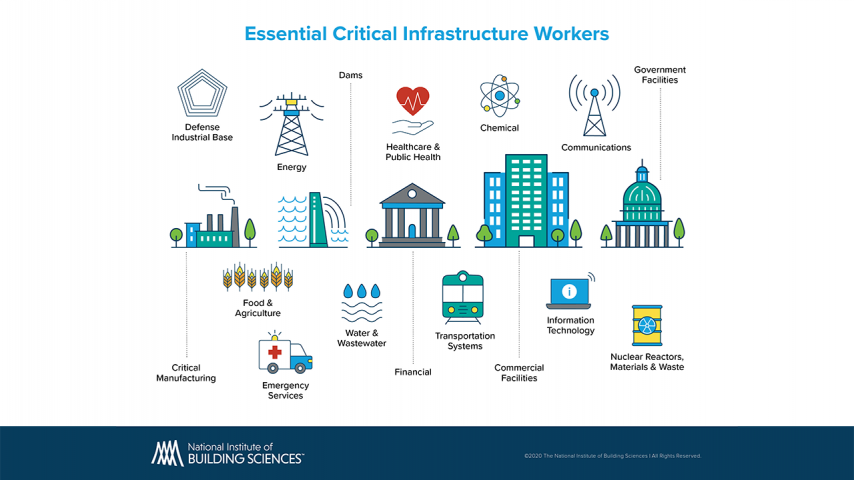
All eyes are on the COVID-19 situation, watching things unfold.
According to the Centers for Disease Control and Prevention (CDC), different parts of the country are seeing different levels of COVID-19 activity.
“The duration and severity of each pandemic phase can vary depending on the characteristics of the virus and the public health response,” the CDC reports, on its situation summary.
The National Institute of Building Sciences continues to closely monitor the situation, particularly as it relates to the built environment and how it affects the industry and our people.
Our chief concerns are those affected – those in self-quarantine, the health care and law enforcement officials on the front lines, critical infrastructure trades officials who must report to work to keep things running smoothly, the businesses whose operations must cease, and the children and students whose institutions have closed.
NIBS will continue to bring experts to the table, as we grapple with this new reality and face head-on what’s needed as it relates to off-site construction and any other resources needed to keep the built environment safe, healthy, and sustainable.
Who’s considered critical infrastructure during this time?
There are 16 critical infrastructure sectors whose assets and systems are considered so vital to the U.S. that their incapacitation or destruction would have a debilitating effect on security, national economic security, public health, or safety.
The U.S. Department of Homeland Security Cybersecurity & Infrastructure Security Agency (CISA) identifies these sectors as chemical, commercial facilities, communications, critical manufacturing, dams, defense industrial base, emergency services, and energy, among others.
Bloomberg has reported how power and gas utilities are keeping energy flowing. For example, there’s no working from home for control room staff, who must physically be present to keep systems operating.
Even The Hill reported that the U.S. power industry may ask essential staff to sleep on site, as the coronavirus outbreak continues to grow.
“Electric power plants are considered ‘critical infrastructure’ by the federal government, meaning as local and state governments impose shutdowns, they will still have to go to work,” the Hill reports.
Industry trade groups and electric cooperatives have said that companies are stockpiling beds, blankets, and food for those employees.
Also critical: water and wastewater systems
Safe drinking water is a prerequisite for protecting public health and all human activity, says CISA.
“Properly treated wastewater is vital for preventing disease and protecting the environment,” it says. “Thus, ensuring the supply of drinking water and wastewater treatment and service is essential to modern life and the nation’s economy.”
The International Association of Plumbing and Mechanical Officials recognizes the announcement that plumbers fall into the category of “essential critical infrastructure workers.”
In an initial list of critical infrastructure workers, CISA Director Christopher C. Krebs said these folks would help “state and local officials as they work to protect their communities, while ensuring continuity of functions critical to public health and safety, as well as economic and national security.”
There are approximately 153,000 public drinking water systems and more than 16,000 publicly owned wastewater treatment systems in the United States, according to CISA. More than 80 percent of the U.S. population receives their potable water from these drinking water systems, and about 75 percent of the U.S. population has its sanitary sewerage treated by these wastewater systems.
Are there small business loans available?
The answer is yes.
The U.S. Small Business Administration provides low-interest disaster loans to help businesses and homeowners recover from declared disasters.
In response to the COVID-19 pandemic, small business owners in all U.S. states, Washington D.C., and territories are eligible to apply for an Economic Injury Disaster Loan advance of up to $10,000.
SBA’s Economic Injury Disaster Loans offer up to $2 million in assistance and can provide vital support to small businesses to help overcome the temporary loss of revenue. Funds will be made available within three days of a successful application, and this loan advance will not have to be repaid.
There’s also the Paycheck Protection Program, which prioritizes millions of Americans employed by small businesses by authorizing up to $349 billion toward job retention and certain other expenses.
Small businesses and eligible nonprofit organizations, Veterans organizations, and Tribal businesses described in the Small Business Act, as well as individuals who are self-employed or are independent contractors, are eligible if they also meet program size standards.
Under this program, eligible recipients may qualify for a loan up to $10 million determined by 8 weeks of prior average payroll plus an additional 25% of that amount. Loan payments will be deferred for 6 months.
Nonprofits eligible for financial help
A coalition of 40 of the nation’s largest charities asked lawmakers for $60 billion in COVID-19 pandemic relief and economic stimulus, The NonProfit Times reports.
On March 27, the Coronavirus Aid, Relief, and Economic Security Act (CARES Act) was passed by Congress, and it included a universal charitable deduction as part of the COVID-19 stimulus relief.
This creates a new above-the-line deduction that applies to all taxpayers for total charitable contributions of up to $300, The NonProfit Times reports. The incentive applies to donations made in 2020 and would be claimed on tax forms next year.
“Nonprofits with fewer than 500 employees will be eligible for $10 million in Emergency Small Business Loans (emergency SBA 7(a) loans),” the Times reports. “The loans can cover costs of payroll, operations, and debt service, and provides that loans be forgiven in whole or in part under certain circumstances, according to guidance from the National Council of Nonprofits. The loans would be eligible to be turned into grants.”
We will continue to stay on top of this story. You can also follow us @bldgsciences on Twitter or on Facebook.




